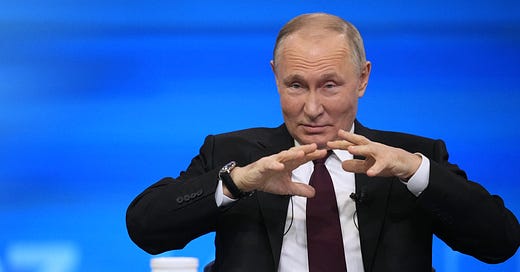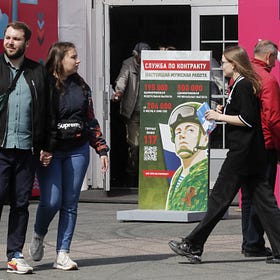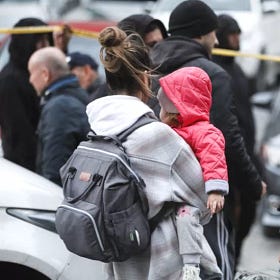"Militarisation in full swing” — How war changed Russia’s economy
Not only has the Russian economy avoided crisis, there is also evidence of growth. But can it last?
By Olga Shamina, Victoria Safronova.

Vladimir Putin likes to boast about Russia’s economy. He spent a good deal of his marathon end of year ‘Direct Line’ televised event talking about it. And it’s true that the Russian economy has demonstrated remarkable resilience in spite of the dire forecasts when sanctions were imposed: there has been no crisis.
Pessimistic statistics have been revised for the better - a contraction of - 2.1% in 2022 was recently revised to - 1.2%. And while there is as yet no official data for 2023, Putin’s optimistic estimate of 3.5% positive growth is quite possible given third quarter figures of 5.5%.
What is the explanation for this unexpectedly rosy situation? The secret is simple, according to economists: heavy defence sector spending.
"The main factor was that in 2023, the militarisation of the economy went into full swing. Budgetary expenditure for the first time became the real driver of economic growth," says Ruben Enikolopov of Pompeu Fabra University in Barcelona.
"Currently, the economy is operating above its potential, exhausting all resources, both labour and capital. In 2023, the question of labour shortage became acute. An economy cannot grow like this. Some enterprises will soon be unable to keep going."
Oleg Itzhoki, from the University of California, agrees. "In 2023, the Russian economy truly became a military one, financed by the state.”
The problem is that this militarised economy, dependent on state funding, is already overheated. And it’s unlikely to be able to sustain growth at the same pace for much longer.
"Currently, the economy is operating above its potential, exhausting all resources, both labour and capital. In 2023, the question of labour shortage became acute. An economy cannot grow like this. Some enterprises will soon be unable to keep going," according to Enikolopov.
In the first months of the war, in the spring of 2022, central bank chief Elvira Nabiullina announced a restructuring of the Russian economy. It called for regulating grey import-export schemes, introducing ‘manual control’ to the economy, and a new redistribution of property.
It all came to a peak in 2023. The Russian economy, criticised before the war for extensive state presence in the form of state-owned companies and large areas of state ownership, became yet more dependent on the state as a consequence of the war. Budget funds have become its main driver.
The obvious question is how to manage an economy that is becoming ever more dependent on state spending. And here another characteristic of 2023 is emerging – increasing signs of ‘manual control’ by the state.
"The economy is truly becoming more hybrid. It was never market-orientated in Russia, but it nevertheless aspired to be. And now it has become hybrid. There are elements of a market economy, as well as a planned one, and there is manual control. How viable this hybrid model will be is very difficult to say right now," says economist Alexandra Osmolovskaya-Suslina.
There’s are growing signs of attempts at manual control – for example, the fight to halt the devaluation of the ruble. The ruble rate on the Moscow stock exchange had been falling since the beginning of 2023, and was getting worse by the end of the summer. At first, the Central Bank mostly used market methods to push back - raising the interest rate and selling rubles. The authorities also tried to agree with exporters that they would repatriate part of their hard currency earnings. None of it worked as quickly as hoped, and the ruble continued to fall.
In early October, the government made it a requirement that exporters sell their foreign exchange earnings. This, along with the impact of the Central Bank's interest rate hike, eventually halted the ruble's decline.
“Everything related to cross-border capital flows, previously governed by retail relationships, is now under manual control,” says Enikolopov.
On top of this, businesses are struggling to cope with a shifting, unpredictable regulatory landscape. "What we have is emergency management: plugging holes in an ad hoc way," says Alexandra Osmolovskaya-Suslina. “Many decisions are being made one way today and another way tomorrow."
Private sector business also faces the threat of expropriation. "The confiscation of foreign companies has started, but I'm afraid this is just the beginning," says Enikolopov. The ownership of domestic businesses has also been called into question.
At the end of December, the Rolf car dealership came under temporary administration by the state property management agency, ‘Rosimushchestvo’. Its main owner was former opposition MP Sergei Petrov, who has left Russia. Earlier, the Baltika brewery and dairy manufacturer Danone also were taken into management by Rosimushchestvo.
Meanwhile, shares in businesses in the occupied territories of Ukraine have also been seized and transferred via complicated ownership schemes to players close to the Russian state.
BBC is blocked in Russia. We’ve attached the story in Russian as a pdf file for readers there.
“A war of attrition”
Early in 2023, many economists were keeping a close eye on the growing budget deficit. But by year’s end, it was clear that the fears had not materialised. By November, the deficit was only 878 billion rubles - significantly below the almost 3 trillion rubles approved by law.
"It’s a war of attrition. And Russia is still far from exhausted,” says Enikopolov. “It’s perfectly possible to keep supporting the economy through state spending and positive growth.”
Last year showed that “the economy can function in a wartime mode,” says Itzhoki. “There is enough money to do so. If a year back, the big question was how long the budget could support the war at such intensity, then in 2023 it became clear: at $80 a barrel and with today's sanctions, there is plenty of money for war."
The Russian government intends to spend about a third of its budget on defence in 2024 – or about 10% of GDP. "This is more than the entire pre-war budget of Ukraine," notes Itzhoki. Assuming oil prices do not fall and sanctions remain unchanged, "2023 showed that funds are unlikely to be a restrictive factor," he says.
Sanctions were intended by the west to weaken Russia's ability to wage war, with an oil embargo and the cap on oil prices. In the early months of 2023, they seemed to be working - the Russian Urals brand was being sold at a significant discount to Brent, and budget revenues from the sale of oil and gas had decreased meaningfully. The result was a 14% reduction in Russian oil export revenues, or a loss of €34 billion, according to the Finnish Centre for Research on Energy and Clean Air.
Over time, however, Moscow began to find ways of bypassing the embargo and the ceiling on oil prices. It created a shadow fleet for transporting of oil, primarily to China and India, numbering more than a hundred tankers, according to the Financial Times. Bloomberg estimates that the shadow fleet accounted for around 45% of Russian oil exports.

"Sanctions have had a very limited effect. They do not restrict the volume of oil that Russia sells, and so far, they have not been very effective in limiting its price,” says Itzhoki. “Maybe at the most there is a discount of 15%. But oil prices have risen more.”
Compared to a democracy, a semi-totalitarian regime reacts differently to sanctions, according to Alexandra Osmolovskaya-Suslina. “I think experience shows that sanctions aren’t working. Sure, there have been some obstacles to manoeuvre around, but they managed it, and the sanctions have failed. The idea had been that people would be upset that there’s no cash, that they can’t travel abroad… but in Russia, the reality is very different.”
Risks around the energy sector remain, however, including a decrease in revenue from the sale of oil, or a bigger discount on its sale, but the Russian economy has a far more urgent problem: an acute labour shortage. The current generation of working age is very small, thanks to conscription into the military and mass emigration. As a result, many job vacancies are going unfilled. As many as 85% of Russian companies have felt the personnel squeeze, according to the ‘SuperJob’ research centre’s portal.
The Russian Central Bank reported a growing shortage of specialists in October-November, with the most significant deficiency in the north-west in manufacturing, and in agriculture in the south, for example.
“The military-industrial complex cannot grow indefinitely, and at some point, there won't be enough money in the budget to bear these inflated expenses.”
"I think the main story of 2023 was a shift from a deficit of goods to a labour shortage," says Isakov. "Conscription, along with voluntary service in the armed forces, as well as migration, have created labour shortages in virtually all industries. In the labour market today, it’s difficult to find an economic indicator that doesn’t speak of deficit: unemployment is at a historic minimum, the ratio of vacancies to job applications is at a maximum, and the growth of salaries in almost all industries is exceeding output growth and labour productivity."
For Vladimir Putin, low unemployment is a source of pride, and evidence of resilience. But economists say it’s a sign of economic overheating, with businesses facing ever increasing costs.
The pinch on the labour market means the Russian economy is unlikely to keep growing at the same rates as it is now, says Enikopolov. Even were the defence sector to be showered with money to hire more workers, it would only raise wages further, and make other sectors less profitable. The economy, he says, would become even more distorted.
"While the military-industrial complex may be growing, other sectors are shrinking," he says. "But if we take a long view, the military-industrial complex cannot grow indefinitely, and at some point, there won't be enough money in the budget to bear these inflated expenses. At which point there will be a full-scale structural problem — not sudden, but a long painful stagnation, most likely, assuming nothing changes militarily or politically."
Such stagnation is also being driven by a lack of access to modern western technologies, not just by economic overheating. The dramatic growth of the defence sector cannot replace western consumer tech.
"The theory that the military-industrial complex can transmogrify into the development of peaceful technologies doesn’t match reality,” says Osmolovskaya-Suslina. “To my mind, when the emphasis is on financing military might, the cash in question is effectively taken out of the economy. An enterprise producing military equipment might receive funds, but money invested in weaponry is torched – it goes to the frontline and is destroyed there.”
As she says, the state’s resources are finite: "The more we spend on defence, the less is left for everything else. Not just for social programs, but also for infrastructure, construction, and so on. Cash gets dragged away from areas that are vitally important for people’s lives," she says.
“The money is just thrown to the wind. Such policies bring zero benefit to ordinary people.”
Read this story in Russian here.
English version edited by Chris Booth.
So many jobs, so few skilled workers - how war and population decline are pushing Russia's economy to the brink
Falling population levels and a mass exodus of skilled workers since the invasion of Ukraine, have left Russia with a growing labour shortage and big question marks over long-term economic security.
Why are people leaving Russia, who are they, and where are they going?
The trickle of Russians leaving their country became a stream after the full-scale invasion of Ukraine of 2022.






